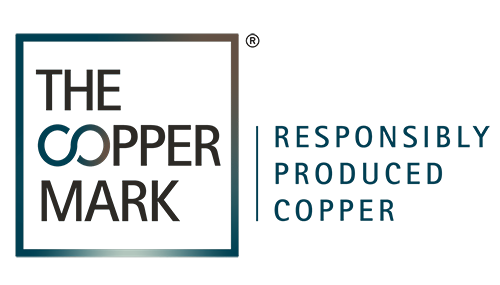The Copper Mark: the seal of responsible mining
23 November 2020
Antofagasta has committed to the Copper Mark, the copper industry’s new responsible production framework, by signing up for independent assurance assessments of its Centinela and Zaldívar mines in Chile. The plan is later to extend the certification process to Los Pelambres and Antucoya.
“The Copper Mark is a voluntary external assurance assessment of the copper industry’s environmental, social and governance practices,” says Iván Arriagada, Chief Executive of Antofagasta. “This confirms our long-standing commitment to transparency and to the highest internationally recognised sustainability standards.”
Launched in March 2020, the Copper Mark assurance process covers 32 sustainability criteria under the five pillars of governance, business and human rights, environment, community, and labour and working conditions. It is initially aimed at copper mines, smelters and refineries but will widen its scope in 2023 to include the full copper fabrication chain.
Major global companies in the copper value chain, such as Ford Motor Company, Google and Intel, have shown their commitment to the objectives of the Copper Mark by becoming Copper Mark Partners. The organisation’s Partners recognise the importance of the responsible production and sourcing of copper by expressing a preference for Copper Mark assured producers.
“The initiative responds to increasing societal demands for responsible production practices,” says Michèle Brülhart, the Executive Director of Copper Mark. The Copper Mark seal offers a credible and simple way for investors, copper end-users and communities to check participants’ claims about sustainability, she says.
The programme addresses issues of concern to society including community engagement, greenhouse gas emissions, safety and health, tailings management, biodiversity, gender equality, and security and human rights. “Its ultimate objective is to strengthen the communities in which copper is produced,” explains Brülhart. “If you set expectations around sustainability it will have a positive impact on the communities and environment in your area of influence.”
“The Copper Mark is also leading a partnership to develop a Joint Due Diligence Standard for copper, lead, nickel and zinc to meet the London Metal Exchange’s (LME) Responsible Sourcing requirements, which will come into force in 2023. Formal LME approval for the standard, as well as the Copper Mark process, will be sought in 2022. The LME actively participates in the standard’s development and is supportive”, says Brülhart.

The process
Copper producers that sign a letter of commitment to the Copper Mark must first complete an online self-assessment. Copper Mark then reviews this information and, if required, requests follow-up onsite visits. When necessary, corrective action plans are drawn up. Improvements must be independently validated to show the producer “fully meets” all criteria within 24 months of signing up. Once the Copper Mark seal has been granted, the producer must be reassessed every three years to demonstrate continued compliance.
“This external independent review will help us to continue improving our responsible mining practices from different perspectives,” explains René Aguilar, Vice President of Corporate Affairs and Sustainability at Antofagasta Minerals. “We are working towards becoming leaders of sustainability in our industry and the Copper Mark is a further and important step forward on this journey.”
The International Copper Association (ICA) began developing the initiative in 2017 in response to growing requests for information on copper producers’ environmental, social and governance (ESG) performance from investors, banks, original equipment manufacturers (OEMs) and NGOs.
After extensive consultation with stakeholders, it was decided to take a comprehensive approach to ESG best practice and adopt the criteria used in the Risk Readiness Assessment (RRA), created by the Responsible Minerals Initiative. The latter brings together 380 companies, including major electronics and automotive brands, which seek responsible mineral sourcing in their supply chains.
In 2019, the Copper Mark was established as a separate entity from ICA to establish its credibility as an independent assurance body. Its governance structure includes a Board of Directors and a multi-stakeholder Advisory Council.
To date, two Rio Tinto mines have successfully completed the assurance programme and been awarded the Copper Mark. Another 12 copper producing operations have started the process, of which Centinela and Zaldívar and three others are in Chile, and four are smelting and refining operations.
Over the next couple of years, Copper Mark aims for companies to shift from signing up just one or two of their sites, to signing letters of commitment for all their operations. In addition, it plans to partner with organisations outside the industry to work with small and medium-sized producers. “The vision is to improve practices in the industry as a whole and not just be a distinction for the best producers,” emphasises Brülhart.
